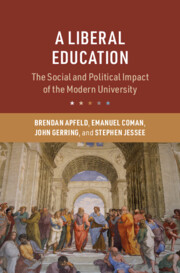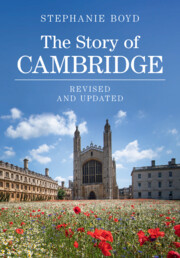87 results
Investigating changes in student mental health and help-seeking behaviour after the introduction of new well-being support services at a UK university
-
- Journal:
- BJPsych Open / Volume 10 / Issue 3 / May 2024
- Published online by Cambridge University Press:
- 27 May 2024, e121
-
- Article
-
- You have access
- Open access
- HTML
- Export citation
12 - Schools and Offices
- from Part II - Essential Signs
-
- Book:
- Chinese Signs
- Published online:
- 29 February 2024
- Print publication:
- 07 March 2024, pp 109-117
-
- Chapter
- Export citation
Teaching Greek: from school to university via fifteenth century Florence
-
- Journal:
- Journal of Classics Teaching , First View
- Published online by Cambridge University Press:
- 27 February 2024, pp. 1-5
-
- Article
-
- You have access
- Open access
- HTML
- Export citation
II.37 - The Pennal Letter from Owain Glyndŵr, Prince of Wales, to the King of France
- from Fifteenth Century
-
- Book:
- The Cambridge Anthology of British Medieval Latin
- Published online:
- 11 January 2024
- Print publication:
- 01 February 2024, pp 330-334
-
- Chapter
- Export citation
4 - Producing Knowledge
-
- Book:
- Academic Freedom and the Transnational Production of Knowledge
- Published online:
- 04 January 2024
- Print publication:
- 25 January 2024, pp 64-90
-
- Chapter
- Export citation

A Liberal Education
- The Social and Political Impact of the Modern University
-
- Published online:
- 28 February 2024
- Print publication:
- 18 January 2024
A systematic review of peer support interventions for student mental health and well-being in higher education
-
- Journal:
- BJPsych Open / Volume 10 / Issue 1 / January 2024
- Published online by Cambridge University Press:
- 15 December 2023, e12
-
- Article
-
- You have access
- Open access
- HTML
- Export citation
3 - Britishness and Chineseness in an Age of Nationalism
-
- Book:
- Multiracial Britishness
- Published online:
- 19 October 2023
- Print publication:
- 02 November 2023, pp 90-131
-
- Chapter
- Export citation
6 - Classy Work
- from Part II - Managing the Global Economy, c.1945–1975
-
- Book:
- Virtue Capitalists
- Published online:
- 07 September 2023
- Print publication:
- 21 September 2023, pp 169-194
-
- Chapter
- Export citation
What next for student mental health?
-
- Journal:
- Irish Journal of Psychological Medicine , First View
- Published online by Cambridge University Press:
- 29 May 2023, pp. 1-3
-
- Article
-
- You have access
- Open access
- HTML
- Export citation
Cambridge: a Famous City
-
- Book:
- The Story of Cambridge
- Published online:
- 23 May 2023
- Print publication:
- 25 May 2023, pp 1-3
-
- Chapter
- Export citation

The Story of Cambridge
-
- Published online:
- 23 May 2023
- Print publication:
- 25 May 2023
5 - Managing Campus Protest
-
- Book:
- Managed Dissent
- Published online:
- 04 May 2023
- Print publication:
- 11 May 2023, pp 117-142
-
- Chapter
- Export citation
Prevalence of fear of COVID-19, depression, and anxiety among undergraduate students during remote classes
-
- Journal:
- Acta Neuropsychiatrica / Volume 35 / Issue 5 / October 2023
- Published online by Cambridge University Press:
- 12 January 2023, pp. 303-313
-
- Article
-
- You have access
- Open access
- HTML
- Export citation
Effects of field of study on university students’ attitudes towards animal issues
-
- Journal:
- Animal Welfare / Volume 23 / Issue 4 / November 2014
- Published online by Cambridge University Press:
- 01 January 2023, pp. 459-466
-
- Article
- Export citation
Chapter 6 - Magic on Retainer
- from Part II - Service Magic among the Social Elite
-
- Book:
- Love Spells and Lost Treasure
- Published online:
- 06 January 2023
- Print publication:
- 22 December 2022, pp 224-245
-
- Chapter
- Export citation
5 - Roman Law, Authority, and Creative Citation
- from Part II - Political and Intellectual Tensions
-
- Book:
- Vernacular Law
- Published online:
- 27 October 2022
- Print publication:
- 03 November 2022, pp 189-230
-
- Chapter
- Export citation
All that was missing from the students of the University of Patras and the return to a new daily life after quarantine
-
- Journal:
- European Psychiatry / Volume 65 / Issue S1 / June 2022
- Published online by Cambridge University Press:
- 01 September 2022, pp. S527-S528
-
- Article
-
- You have access
- Open access
- Export citation
Student mental health during the first two years of the COVID- 19 pandemic
-
- Journal:
- European Psychiatry / Volume 65 / Issue S1 / June 2022
- Published online by Cambridge University Press:
- 01 September 2022, p. S535
-
- Article
-
- You have access
- Open access
- Export citation
Examining the association between personality traits and university faculty: a web-survey among Italian students
-
- Journal:
- European Psychiatry / Volume 65 / Issue S1 / June 2022
- Published online by Cambridge University Press:
- 01 September 2022, p. S180
-
- Article
-
- You have access
- Open access
- Export citation



